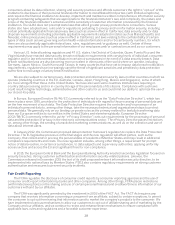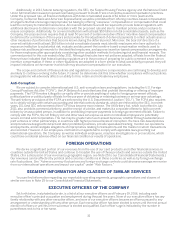American Express 2015 Annual Report Download - page 35
Download and view the complete annual report
Please find page 35 of the 2015 American Express annual report below. You can navigate through the pages in the report by either clicking on the pages listed below, or by using the keyword search tool below to find specific information within the annual report.
Since January 1, 2014, subject to certain transitional provisions, the Company, Centurion Bank and American
Express Bank have been subject to the federal banking regulators’ revised capital rules (the “New Capital Rules”). The
New Capital Rules substantially revised the general risk-based capital rules previously applicable to banking
organizations to make them more risk sensitive and largely implement the Basel Committee on Banking Supervision’s
(“Basel Committee”) final framework for strengthening international capital regulation, known as Basel III. For
additional information regarding our capital ratios, see “Consolidated Capital Resources and Liquidity” under “MD&A.”
New Capital Rules
Under the New Capital Rules, new minimum capital and buffer requirements were established and will be fully
phased-in by 2019. Specifically, banking organizations are required to maintain minimum ratios for Common Equity
Tier 1 (“CET1”), Tier 1 and Total capital to risk-weighted assets. In addition, all banking organizations remain subject to
a minimum leverage ratio of Tier 1 capital to total adjusted average assets (as defined for regulatory purposes).
Advanced approaches institutions, such as the Company, will also become subject to a supplementary leverage ratio.
In addition, advanced approaches institutions calculate risk-based capital ratios under both the generally applicable
standardized approach and the advanced approaches capital rule, and then use the lower of each capital ratio to
determine whether it meets its minimum risk-based capital requirements. The portions of the New Capital Rules
implementing the standardized approach became effective January 1, 2015.
During 2014, we began reporting our capital adequacy ratios on a parallel basis to federal banking regulators using
both risk-weighted assets calculated under the Basel III standardized approach, as adjusted for certain items, and the
requirements for an advanced approaches institution. During this parallel period, federal banking regulators assess
our compliance with the advanced approaches requirements. We continue to make progress in complying with the
requirements, including refining our calculations to align the requirements with our asset types. The parallel period will
continue until we receive regulatory approval to exit parallel reporting, at which point we will begin publicly reporting
capital ratios using risk-weighted assets calculated under both the advanced approaches and the standardized
approach in the New Capital Rules, and will be required to use the lower of these ratios in order to determine whether
we are in compliance with minimum capital requirements. Depending on how the advanced approaches are ultimately
implemented for our asset types, our capital ratios calculated under the advanced approaches may be lower than
under the standardized approach. The Federal Reserve has indefinitely delayed use of the advanced approaches in
CCAR and, therefore, the standardized approach will remain the applicable measurement for such purposes.
Commencing January 1, 2015, the Company, Centurion Bank and American Express Bank must each maintain
CET1, Tier 1 capital (that is, CET1 plus additional Tier 1 capital) and Total capital (that is, Tier 1 capital plus Tier 2
capital) ratios of at least 4.5 percent, 6.0 percent and 8.0 percent, respectively, without giving effect to the capital
conservation buffer or countercyclical capital buffer discussed below.
The New Capital Rules also implement a 2.5 percent capital conservation buffer composed entirely of CET1, on top
of these minimum risk-weighted asset ratios. As a result, the minimum ratios are effectively 7.0 percent, 8.5 percent
and 10.5 percent for the CET1, Tier 1 capital and Total capital ratios, respectively, on a fully phased-in basis.
Implementation of the capital conservation buffer began on January 1, 2016 at the 0.625 percent level and will increase
in equal increments at the beginning of each year until it is fully implemented on January 1, 2019. Additionally, as noted
above, the required minimum capital ratios for advanced approaches institutions such as the Company may be further
increased by a countercyclical capital buffer composed entirely of CET1 up to 2.5 percent, which may be assessed
when federal banking regulators determine that such a buffer is necessary to protect the banking system from
disorderly downturns associated with excessively expansionary periods. As a result, when fully phased-in, the
countercyclical capital buffer and capital conservation buffer could potentially result in effective minimum CET1, Tier 1
capital and Total capital ratios of 9.5 percent, 11.0 percent and 13.0 percent, respectively.
Banking institutions whose ratio of CET1, Tier 1 Capital or Total capital to risk-weighted assets is above the
minimum but below the capital conservation buffer (or below the combined capital conservation buffer and
countercyclical capital buffer, when the latter is applied) will face constraints on discretionary distributions such as
dividends, repurchases and redemptions of capital securities, and executive compensation based on the amount of
the shortfall.
As a supervisory matter, federal banking regulators expect most bank holding companies, and in particular larger
bank holding companies such as the Company, to maintain regulatory capital ratios that, at a minimum, qualify a bank
holding company and its depository institution subsidiaries as “well capitalized.” The rules also provide that bank
holding companies experiencing internal growth or making acquisitions will be expected to maintain strong capital
positions substantially above the minimum supervisory levels without significant reliance on intangible assets. For
example, the Federal Reserve has indicated that it will consider a “tangible Tier 1 capital leverage ratio” (deducting all
intangibles) and other indicators of capital strength in evaluating proposals for expansion or new activities.
Furthermore, since the 2008-2009 financial crisis, federal banking regulators have encouraged larger bank holding
companies to maintain capital ratios appreciably above the “well capitalized” standard. The Federal Reserve has also
focused on the regulatory requirement that common equity be the “predominant” element of Tier 1 capital.
24
























